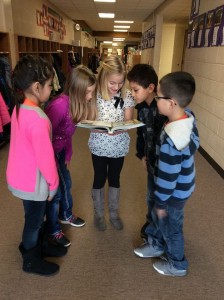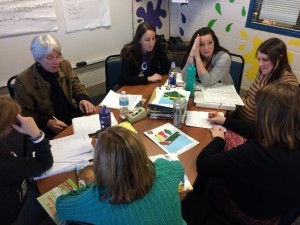It’s that time of year again where the days are shorter and many of our students spend less and less time being active. As an antidote to those winter wiggles, teachers across our schools are working together to provide students with unique learning opportunities throughout the day. Our recent evaluation report revealed that strategic implementation of the pillars of Turnaround Arts at our most high-achieving pilot schools was heavily supported by increased teacher collaboration. When teachers shared their ideas and experiences with each other, they transcended the walls of their classroom and fostered a community that celebrated hard work and creativity. Our newer schools are carrying that torch forward and finding innovative ways to increase teacher collaboration in service to their strategic arts goals this year.
 Turnaround Arts: Minnesota uses teacher collaboration to support the implementation and extension of arts-based strategies and arts integration in the classroom. Many teacher leaders capitalize on professional learning communities (PLCs) or grade-level planning time to bring in arts standards or arts-based strategies and discover new ways of teaching content. Often, teachers find that seeing an arts-integrated lesson in action or hearing about it from a colleague gives them extra understanding and confidence to give it a try in their own classrooms. At Northport Elementary, arts specialists rotate through grade-level team meetings to provide ideas for how to integrate the arts with their regular classroom content.
Turnaround Arts: Minnesota uses teacher collaboration to support the implementation and extension of arts-based strategies and arts integration in the classroom. Many teacher leaders capitalize on professional learning communities (PLCs) or grade-level planning time to bring in arts standards or arts-based strategies and discover new ways of teaching content. Often, teachers find that seeing an arts-integrated lesson in action or hearing about it from a colleague gives them extra understanding and confidence to give it a try in their own classrooms. At Northport Elementary, arts specialists rotate through grade-level team meetings to provide ideas for how to integrate the arts with their regular classroom content.
Some Turnaround Arts: Broward County schools employ a similar strategy in deepening teacher content and arts knowledge. The first grade team at Lake Forest Elementary works as a grade level team to both share unique arts integrated ideas and brainstorm new ways to use the arts in their class. Recently they came together to find a solution to the lack of detail in their students’ writing. The teachers decided to try Visual Thinking Strategies (VTS) a few times a week as a way to improve students’ vocabulary, attention to detail, and ability to support their thinking with evidence. In just a few weeks they’ve seen improvement in students’ use of details and their writing stamina. Early Childhood Education (ECE) Coaches and Arts Leadership Team members also serve as peer advisors in grade-level team meetings to share their experience and encourage and support their peers.
 In Bridgeport, Turnaround Arts schools are also exploring innovative ways for teachers to share ideas. The ECE Coaches in that region work in other Turnaround Arts: Bridgeport schools to provide peer feedback on how teachers are weaving the arts into their lessons as a way to deliver instruction in a more dynamic and kinesthetic way. At Barnum School, the arts team is leading the charge for collaboration. Members become primary owners of an arts strategy and then travel around to different classrooms to model those strategies in other classrooms. After a professional development session, this second exposure to an arts strategy in context often propels teachers to feel comfortable using it independently.
In Bridgeport, Turnaround Arts schools are also exploring innovative ways for teachers to share ideas. The ECE Coaches in that region work in other Turnaround Arts: Bridgeport schools to provide peer feedback on how teachers are weaving the arts into their lessons as a way to deliver instruction in a more dynamic and kinesthetic way. At Barnum School, the arts team is leading the charge for collaboration. Members become primary owners of an arts strategy and then travel around to different classrooms to model those strategies in other classrooms. After a professional development session, this second exposure to an arts strategy in context often propels teachers to feel comfortable using it independently.
In addition to the three regions highlighted here, great collaborative relationships are developing all across the country. Those relationships are resulting in students who are given the freedom to be creative and display their learning in different ways, and teachers who feel empowered to push their students to higher levels of thinking and creating (and not to mention having fun doing it)!
 April 2016 Newsletter: Notes from the Field
April 2016 Newsletter: Notes from the Field